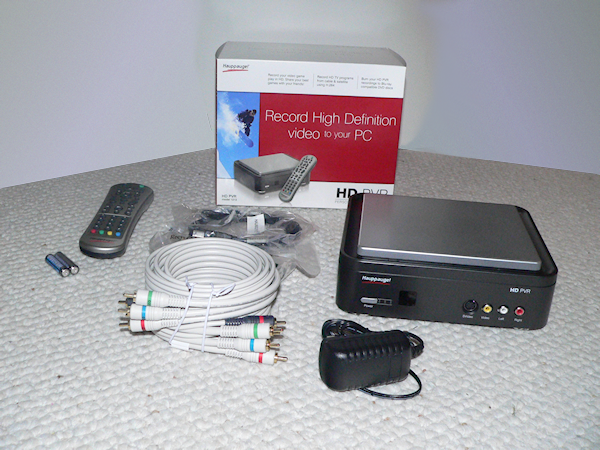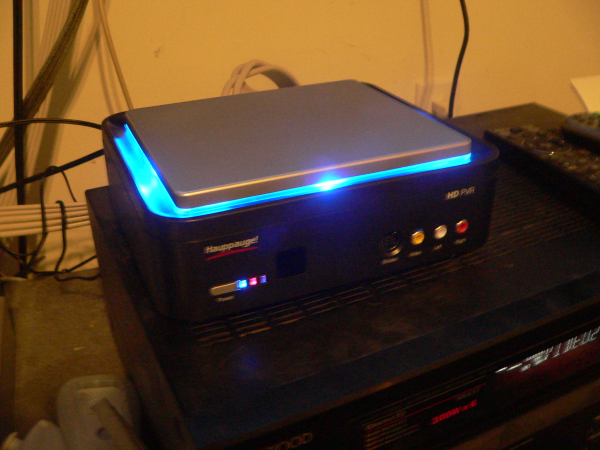Hauppauge HD PVR and Windows Media Center: Is it the working-class TiVo?
The promise of Hauppauge's HD PVR digital recording device is that it will enable you to use the expensive television signal being piped into your house, on your own terms. Just a few years ago, it seemed, it was easier for most folks to be able to use that signal however and whenever they wanted, and TiVo blasted open the doors for people with busy lives to start, stop, restart, collect, and re-watch the programs that made the intervening hours between crises somewhat enjoyable.
But since then, the restraints and constraints started re-appearing -- the same-room recording restrictions, the "broadcast flags," the availability constraints, the second-run and third-run limitations that make lower-class viewers wait for upper-class viewers to be served first. As studios and content providers act on their second thoughts about opening up digital availability, "on demand" is becoming more of a misnomer. Perhaps "on plea" is more appropriate.

Hauppauge HD PVR, available for $199 through hauppauge.com
"I don't know about you, but my cable TV bill is close to $200 a month. For $200 a month, I want to be able to record my programs, to watch them whenever I want, and not be limited to recording in one room and having to watch in that same room," said Ken Plotkin, the CEO of Hauppauge Computer Works (pronounced "Hup-hog," for all you non-New Yorkers), in an interview with Betanews. "We think that multi-room DVR is the next step in allowing consumers to be able to get access to the kinds of programming that they want to watch, no matter where they are or what time it is. I can tell you that all of the consumers that I've spoken to, including my family and friends, feel that the DVR has been a life-changing experience. . . We believe that the technologies that both the PC [device] manufacturers like Hauppauge and the consumer electronics manufacturers like TiVo have delivered to the consumer market have been, if not life changing, at least experience changing for most consumers."
The truth is, the television viewing "experience" has been changing on an ongoing basis, both before and since the onset of TiVo. Since US broadcasters have completed their shift to digital over-the-air transmission, cable companies have been stepping up their efforts to shift their customers towards (artificially) costlier digital receivers. As a result, not only are fewer (or no) channels available through analog cable lines in many communities, but fewer (or no) channels are being made available through the general-class digital service known as ClearQAM. This is the space Comcast and other cable providers have delegated for the carriage of their local service areas' broadcast signals, as they are compelled to do by law. By removing basic cable channels such as USA and CNN from ClearQAM, the segment of cable spectrum occupied by broadcasters become automatically cast as second- or third-class, bargain-basement, less desirable. And that seems to be the plan, especially for cable service providers that are themselves becoming larger content providers as well.
So what was perfectly recordable television circa 2008 using home-grown equipment, including Hauppauge WinTV cards, suddenly became out of reach in 2009 and '10. As early as 2005, Intel and AMD began enticing builders with the idea of "media PCs," home entertainment complexes that provided access to thousands of digital sources, each on an equivalent basis with one another, all under the user's direct control. Then the asterisks started appearing beside "direct control," as HDTV and STB manufacturers began adopting HDMI, and content providers took advantage of their opportunity to limit the way consumers made "extended use" of the digital signals they were paying for.
Although recording and non-commercial viewing of a signal constitute "fair use" under US copyright law, consumers who bought into the media PC idea found themselves taking extraordinary measures to be able to reuse the content riding those signals in a fair way. When Windows Media Center first premiered with Windows XP, the STB industry was not very pleased. It took the initiative not of Microsoft but of individual engineers like Tim Moore to make Media Center work with a Firewire cable just to change the STB's channels; and periodically, Microsoft and others took steps to undo those initiatives with driver releases and security updates. Today, even though Media Center is one of the key selling points of Windows 7, few customers can actually use it to control all, or in some cases even any, of the television they're paying for.

Hauppauge HD PVR shows its excitement by glowing as it records.
HD PVR is another of those "extraordinary measures" available to consumers: a wedge that people can drive into the digital pipeline to re-enable the fair use that the very design of their system would otherwise deny them. It isn't a piracy device or a reverse-engineering of the digital signal. In fact, it doesn't even record the digital signal: It takes advantage of the analog connections that many consumers use between their tuners and HDTVs, to siphon off image and sound that can then be re-recorded digitally. It's not stealing anything, nor is it actually recording anything of commercial resale quality.
And contrary to its appearance, it doesn't even include its own hard drive. You supply the PC and the recording media; HD PVR is essentially an analog signal interception device with software. Because it leaves room for so many component cables (YPbPr), composite cables (RCA stereo), and optical cables, it can't all fit on a PC card or USB thumb device like Hauppauge's well-known tuners. Once plugged in, HD PVR looks less like a hi-fi component and more like a portable cardiac monitor. In my house, where a visitor is likely to find any number of boxes I've built with wires hanging out of them, it doesn't look so out of place. But frankly, despite Hauppauge's best efforts to make it attractive -- including the airport runway-like blue LED canals along the upper ridge that glow while it's recording -- most home entertainment component owners will probably want to keep this thing tucked away and out of sight.
Next: Wedging WinTV into Windows
